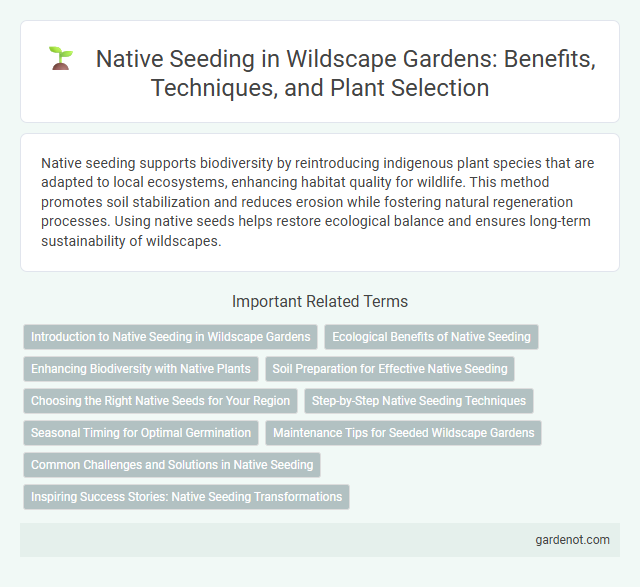Native seeding supports biodiversity by reintroducing indigenous plant species that are adapted to local ecosystems, enhancing habitat quality for wildlife. This method promotes soil stabilization and reduces erosion while fostering natural regeneration processes. Using native seeds helps restore ecological balance and ensures long-term sustainability of wildscapes.
Introduction to Native Seeding in Wildscape Gardens
Native seeding in Wildscape gardens fosters biodiversity by using regionally adapted plant species that thrive naturally within local ecosystems. This practice enhances habitat restoration, supports pollinators, and improves soil health while preserving genetic diversity unique to the area. By integrating native seed mixes, Wildscape gardens promote sustainable landscapes that require less maintenance and resist invasive species.
Ecological Benefits of Native Seeding
Native seeding enhances soil health by promoting microbial diversity and improving nutrient cycling, which supports sustainable ecosystems. It increases habitat availability for pollinators, birds, and other wildlife, boosting regional biodiversity. By using plants adapted to local conditions, native seeding reduces erosion and water runoff, stabilizing landscapes and maintaining natural hydrological cycles.
Enhancing Biodiversity with Native Plants
Native seeding plays a crucial role in enhancing biodiversity by restoring natural habitats with indigenous plant species adapted to local ecosystems. Using native plants supports a wide range of wildlife, including pollinators, birds, and soil microorganisms, which depend on these species for food and shelter. Incorporating native seeds in wildscape projects improves soil health, promotes balanced nutrient cycles, and fosters resilient ecosystems capable of withstanding environmental stress.
Soil Preparation for Effective Native Seeding
Proper soil preparation is critical for effective native seeding in wildscape restoration, involving the removal of invasive species and the loosening of compacted soil to enhance seed-to-soil contact. Incorporating organic matter and ensuring soil pH aligns with native plant requirements boosts germination rates and seedling vigor. Consistent moisture management combined with minimal soil disturbance maintains optimal conditions for native seed establishment and long-term ecosystem resilience.
Choosing the Right Native Seeds for Your Region
Selecting native seeds tailored to your specific region ensures higher germination rates and promotes ecological balance by supporting local wildlife. Prioritize seeds from local sources that are genetically adapted to the climate, soil type, and seasonal patterns of your area. Utilizing regionally appropriate native seeds helps restore natural habitats, enhances biodiversity, and reduces maintenance requirements in wildscape projects.
Step-by-Step Native Seeding Techniques
Step-by-step native seeding techniques ensure successful plant establishment by selecting region-specific seed varieties adapted to local climate and soil conditions. Preparing the site involves clearing invasive species, loosening soil, and creating seedbeds to optimize germination rates. Precise seed dispersal methods, such as broadcasting or drilling, combined with proper timing aligned to seasonal rainfall patterns, maximize growth and biodiversity in wildscapes.
Seasonal Timing for Optimal Germination
Native seeding success depends on precise seasonal timing to align with natural precipitation and temperature cycles. Optimal germination occurs when seeds are sown in early fall, allowing them to undergo cold stratification over winter and sprout in spring. This timing minimizes seed predation and maximizes moisture availability, crucial for native plant establishment in wildscape restoration projects.
Maintenance Tips for Seeded Wildscape Gardens
Regular watering during the initial growth phase is crucial for successful native seeding in wildscape gardens to ensure seed germination and establishment. Mulching with organic materials helps retain soil moisture, suppress weeds, and protect young seedlings from temperature fluctuations. Periodic inspection for invasive species and timely removal prevents competition, supporting the healthy development of native plants.
Common Challenges and Solutions in Native Seeding
Native seeding in wildscape restoration often faces challenges such as poor seed germination, soil erosion, and invasive species competition. Addressing these issues involves selecting high-quality, locally adapted seed varieties, implementing erosion control measures like mulch or wattles, and applying targeted weed management practices to ensure successful plant establishment. Monitoring soil health and moisture levels further enhances seedling survival and promotes sustainable ecosystem recovery.
Inspiring Success Stories: Native Seeding Transformations
Native seeding at Wildscape has transformed degraded landscapes into thriving ecosystems by restoring indigenous plant species crucial for biodiversity. Success stories highlight how targeted seeding efforts have increased pollinator populations and improved soil health, demonstrating measurable ecological benefits. These transformations provide scalable models for habitat restoration, emphasizing the importance of native flora in ecological resilience.
Native seeding Infographic

 gardenot.com
gardenot.com